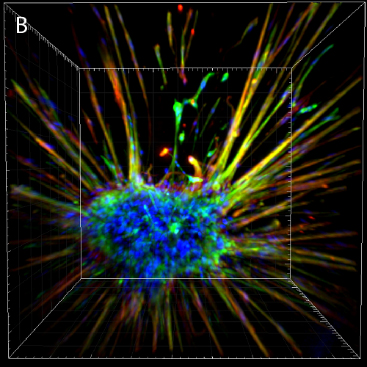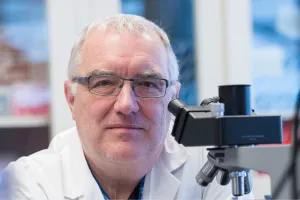3D gel helps researchers find potential drugs for lung cancer, other diseases
 Lung cancer cells grown in a spongy 3D gel that mimics lung tissue. Photo credit Julien Yockell-Lelièvre and Roger TamResearchers in Ottawa and Toronto have created a spongy 3D gel that mimics lung tissue, allowing them to quickly screen hundreds of potential drugs for lung cancer and other diseases.
Lung cancer cells grown in a spongy 3D gel that mimics lung tissue. Photo credit Julien Yockell-Lelièvre and Roger TamResearchers in Ottawa and Toronto have created a spongy 3D gel that mimics lung tissue, allowing them to quickly screen hundreds of potential drugs for lung cancer and other diseases.
The system is helping the researchers find drugs that not only slow cancer's growth, but also prevent its ability to invade healthy tissues. This is crucial because cancer drugs that only target one of these pathways are more likely to fail.
They tested the system on cells from patients at The Ottawa Hospital, showing that while lung cancer cells (shown at right) could readily invade and spread throughout the gel, normal lung cells did not.
They have also screened over 800 potential drugs for activity against a disease called lymphangioleiomyomatosis (LAM), which is similar to lung cancer. This allowed them to discover several novel approaches to target this disease.
Dr. William Stanford of The Ottawa Hospital and the University of Ottawa and Dr. Molly Shoichet of the University of Toronto are co-senior authors on the paper, which is published in Advanced Materials.
Additional authors: Roger Y. Tam, Julien Yockell-Lelièvre, Laura J. Smith, Lisa M. Julian, Alexander E. G. Baker, Chandarong Choey, Mohamed S. Hasim, Jim Dimitroulakos.
Core resources: High Content Imaging Core, Human Pluripotent Stem Cell Facility
Funding: Research at The Ottawa Hospital is possible because of generous donations to The Ottawa Hospital Foundation. This study was also supported by the Canadian Institute of Health Research, the Natural Sciences and Engineering Research Council of Canada, the Canada Research Chair Program, the McEwen Centre for Regenerative Medicine, Green Eggs and LAM, the LAM Foundation, the United States Department of Defense, the Ontario Institute of Regenerative Medicine, the Canada Foundation for Innovation and the Ontario Research Fund.
The Ottawa Hospital: Inspired by research. Driven by compassion
The Ottawa Hospital is one of Canada's largest learning and research hospitals with over 1,100 beds, approximately 12,000 staff and an annual budget of over $1.2 billion. Our focus on research and learning helps us develop new and innovative ways to treat patients and improve care. As a multi-campus hospital, affiliated with the University of Ottawa, we deliver specialized care to the Eastern Ontario region, but our techniques and research discoveries are adopted around the world. We engage the community at all levels to support our vision for better patient care. See www.ohri.ca for more information about research at The Ottawa Hospital.
University of Ottawa: --A crossroads of cultures and ideas
The University of Ottawa is home to over 50,000 students, faculty and staff, who live, work and study in both French and English. Our campus is a crossroads of cultures and ideas, where bold minds come together to inspire game-changing ideas. We are one of Canada's top 10 research universities--our professors and researchers explore new approaches to today's challenges. One of a handful of Canadian universities ranked among the top 200 in the world, we attract exceptional thinkers and welcome diverse perspectives from across the globe. www.uottawa.ca
Media Contact
Jennifer Ganton
Director, Communications and Public Relations
Ottawa Hospital Research Institute
Office: 613-798-5555 x 73325
Cell: 613-614-5253
jganton@ohri.ca
Learn more about:
The Ottawa Hospital is a leading academic health, research and learning hospital proudly affiliated with the University of Ottawa and supported by The Ottawa Hospital Foundation.


